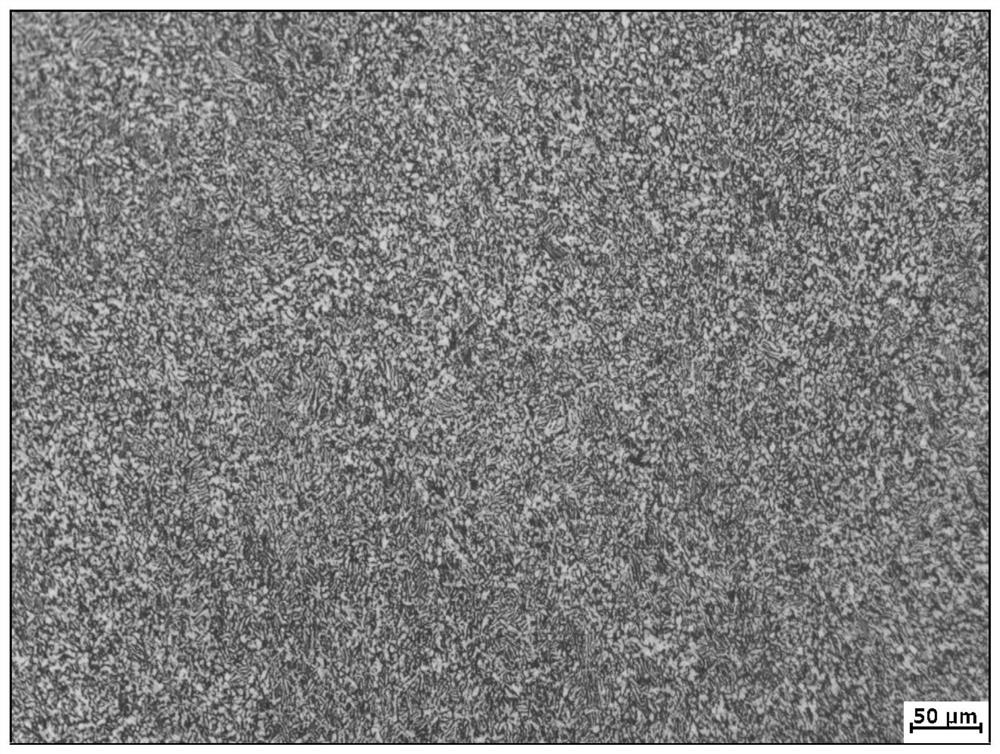Medium-strength nitric acid corrosion-resistant titanium alloy
A titanium alloy and strength technology, applied in the field of titanium alloys, can solve the problem of not meeting the strength requirements of transmission components
- Summary
- Abstract
- Description
- Claims
- Application Information
AI Technical Summary
Problems solved by technology
Method used
Image
Examples
Embodiment 1
[0021] The medium-strength nitric acid corrosion-resistant titanium alloy of this embodiment is composed of the following components in mass percentage: Ta5.5%, Al 0.7%, Zr 1.0%, Mo 0.8%, Nb 1.1%, and the balance is Ti and unavoidable impurities.
[0022] This embodiment includes the following steps:
[0023] Step 1, mixing Ti-50% Ta master alloy, Ti-30% Mo master alloy, Al-70% Nb master alloy, aluminum beans, sponge zirconium and sponge titanium, and then pressing to obtain an electrode;
[0024] Step 2, melting the electrode obtained in Step 1 three times in a vacuum consumable electric arc furnace to obtain an ingot;
[0025] Step 3. Carrying out billet forging three times at 1150° C., 1050° C. and 950° C. respectively on the ingot obtained in step 2 to obtain the forged ingot;
[0026] Step 4. Convert the forged ingot obtained in Step 3 into a rolled billet at 850° C., and then perform finished rolling at 870° C. to obtain a medium-strength nitric acid corrosion-resistant...
Embodiment 2
[0052] The medium-strength nitric acid corrosion-resistant titanium alloy in this embodiment is composed of the following components in mass percentage: Ta 5.0%, Al 0.9%, Zr 2.0%, Mo 1.0%, Nb 0.7%, and the balance is Ti and unavoidable impurities.
[0053] This embodiment includes the following steps:
[0054] Step 1, mixing Ti-50% Ta master alloy, Ti-30% Mo master alloy, Al-70% Nb master alloy, aluminum beans, sponge zirconium and sponge titanium, and then pressing to obtain an electrode;
[0055] Step 2, melting the electrode obtained in Step 1 three times in a vacuum consumable electric arc furnace to obtain an ingot;
[0056] Step 3. Carrying out billet forging three times at 1150° C., 1050° C. and 950° C. respectively on the ingot obtained in step 2 to obtain the forged ingot;
[0057] Step 4. The forged ingot obtained in Step 3 is converted into a rolled billet at 900°C, and then rolled at 830°C to obtain a medium-strength nitric acid corrosion-resistant titanium alloy ...
Embodiment 3
[0061] The medium-strength nitric acid corrosion-resistant titanium alloy in this embodiment is composed of the following components in mass percentage: Ta 6.0%, Al 1.1%, Zr 1.5%, Mo 0.6%, Nb 2.0%, and the balance is Ti and unavoidable impurities.
[0062] This embodiment includes the following steps:
[0063] Step 1, mixing Ti-50% Ta master alloy, Ti-30% Mo master alloy, Al-70% Nb master alloy, aluminum beans, sponge zirconium and sponge titanium, and then pressing to obtain an electrode;
[0064] Step 2, melting the electrode obtained in Step 1 three times in a vacuum consumable electric arc furnace to obtain an ingot;
[0065] Step 3. Carrying out billet forging three times at 1150° C., 1050° C. and 950° C. respectively on the ingot obtained in step 2 to obtain the forged ingot;
[0066] Step 4. Convert the forged ingot obtained in Step 3 into a rolled billet at 870° C., and then perform finished rolling at 850° C. to obtain a medium-strength nitric acid corrosion-resistan...
PUM
| Property | Measurement | Unit |
|---|---|---|
| Cross section diameter | aaaaa | aaaaa |
| Tensile strength | aaaaa | aaaaa |
| Yield strength | aaaaa | aaaaa |
Abstract
Description
Claims
Application Information
 Login to View More
Login to View More - R&D
- Intellectual Property
- Life Sciences
- Materials
- Tech Scout
- Unparalleled Data Quality
- Higher Quality Content
- 60% Fewer Hallucinations
Browse by: Latest US Patents, China's latest patents, Technical Efficacy Thesaurus, Application Domain, Technology Topic, Popular Technical Reports.
© 2025 PatSnap. All rights reserved.Legal|Privacy policy|Modern Slavery Act Transparency Statement|Sitemap|About US| Contact US: help@patsnap.com

